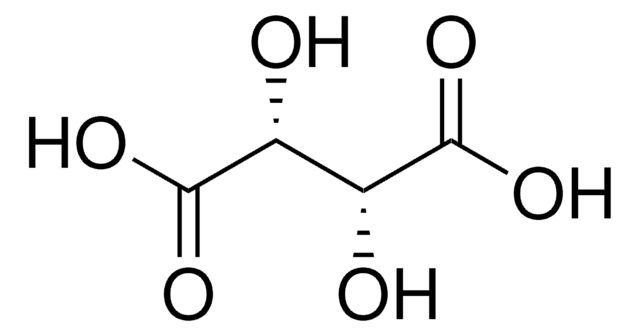Key Documents
W304409
L-(+)-Tartaric acid
≥99.7%, FCC, FG
Synonim(y):
(2R,3R)-(+)-Tartaric acid, L-Threaric acid
About This Item
Polecane produkty
pochodzenie biologiczne
synthetic
Poziom jakości
klasa czystości
FG
Halal
agency
meets purity specifications of JECFA
zgodność regionalna
EU Regulation 1334/2008 & 178/2002
FCC
FDA 21 CFR 163.110
FDA 21 CFR 163.111
FDA 21 CFR 163.112
FDA 21 CFR 184.1099
gęstość pary
5.18 (vs air)
Próba
≥99.7%
Postać
crystalline powder
aktywność optyczna
[α]20/D +12.5°, c = 20 in H2O
temp. samozapłonu
797 °F
mp
170-172 °C (lit.)
rozpuszczalność
water: soluble 150 g/L at 25 °C
ślady kationów
As: ≤3 ppm
Cd: ≤1 ppm
Hg: ≤1 ppm
heavy metals (as Pb): ≤2 ppm
Zastosowanie
flavors and fragrances
Dokumentacja
see Safety & Documentation for available documents
alergen pokarmowy
no known allergens
Organoleptyczne
odorless
ciąg SMILES
O[C@H]([C@@H](O)C(O)=O)C(O)=O
InChI
1S/C4H6O6/c5-1(3(7)8)2(6)4(9)10/h1-2,5-6H,(H,7,8)(H,9,10)/t1-,2-/m1/s1
Klucz InChI
FEWJPZIEWOKRBE-JCYAYHJZSA-N
Szukasz podobnych produktów? Odwiedź Przewodnik dotyczący porównywania produktów
Opis ogólny
Zastosowanie
- Terahertz-spectroscopy for non-destructive determination of crystallinity of L-tartaric acid in smartFilms and tablets made from paper.: This study leverages terahertz spectroscopy to assess the crystallinity of L-(+)-tartaric acid in innovative pharmaceutical applications, enhancing non-destructive testing methods for quality control (Ornik et al., 2020 May). Link to the article.
- Enhanced pulmonary absorption of poorly soluble itraconazole by micronized cocrystal dry powder formulations.: Research shows the use of L-(+)-tartaric acid in cocrystal formulations with itraconazole to improve its pulmonary absorption, demonstrating a significant advancement in drug delivery technologies (Karashima et al., 2017 Jun). Link to the article.
- Physicochemical Evaluation and Developability Assessment of Co-amorphouses of Low Soluble Drugs and Comparison to the Co-crystals.: This article discusses the role of L-(+)-tartaric acid in enhancing the solubility and bioavailability of pharmaceuticals through co-amorphous systems, offering a critical insight into drug formulation strategies (Yamamoto et al., 2016 Dec). Link to the article.
- Functionalized polycarbonate derived from tartaric acid: enzymatic ring-opening polymerization of a seven-membered cyclic carbonate.: This research explores the synthesis of biodegradable polymers from L-(+)-tartaric acid, emphasizing its utility in developing environmentally friendly materials (Wu et al., 2008 Oct). Link to the article.
Hasło ostrzegawcze
Danger
Zwroty wskazujące rodzaj zagrożenia
Zwroty wskazujące środki ostrożności
Klasyfikacja zagrożeń
Eye Dam. 1
Kod klasy składowania
11 - Combustible Solids
Klasa zagrożenia wodnego (WGK)
WGK 1
Temperatura zapłonu (°F)
302.0 °F - closed cup
Temperatura zapłonu (°C)
150 °C - closed cup
Środki ochrony indywidualnej
dust mask type N95 (US), Eyeshields, Gloves
Wybierz jedną z najnowszych wersji:
Masz już ten produkt?
Dokumenty związane z niedawno zakupionymi produktami zostały zamieszczone w Bibliotece dokumentów.
Klienci oglądali również te produkty
Nasz zespół naukowców ma doświadczenie we wszystkich obszarach badań, w tym w naukach przyrodniczych, materiałoznawstwie, syntezie chemicznej, chromatografii, analityce i wielu innych dziedzinach.
Skontaktuj się z zespołem ds. pomocy technicznej











